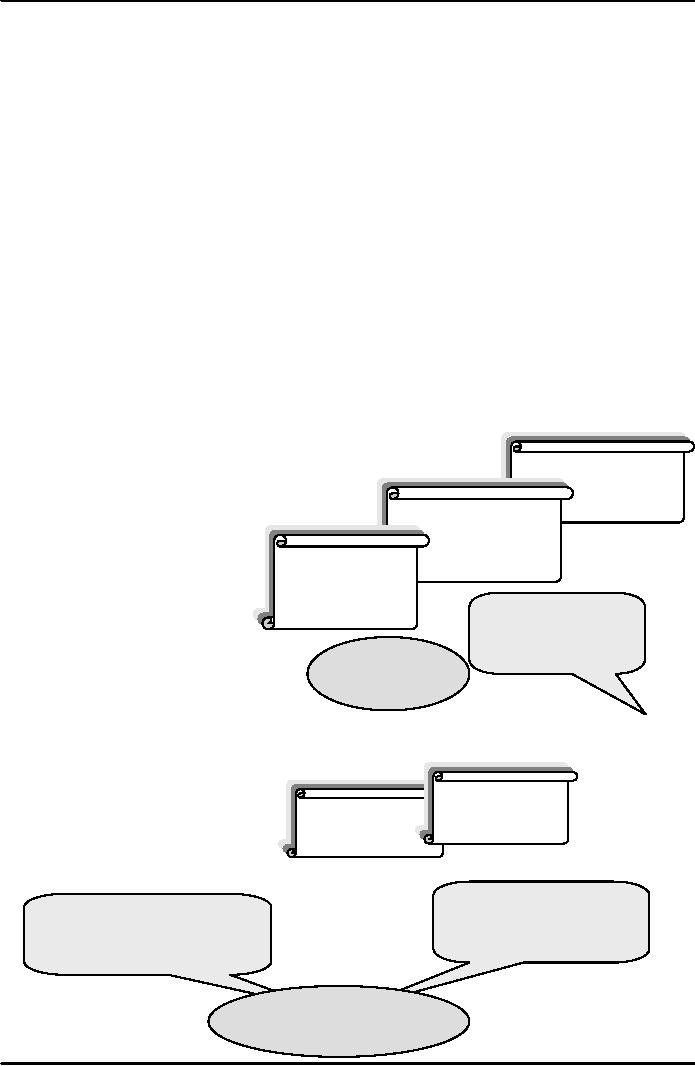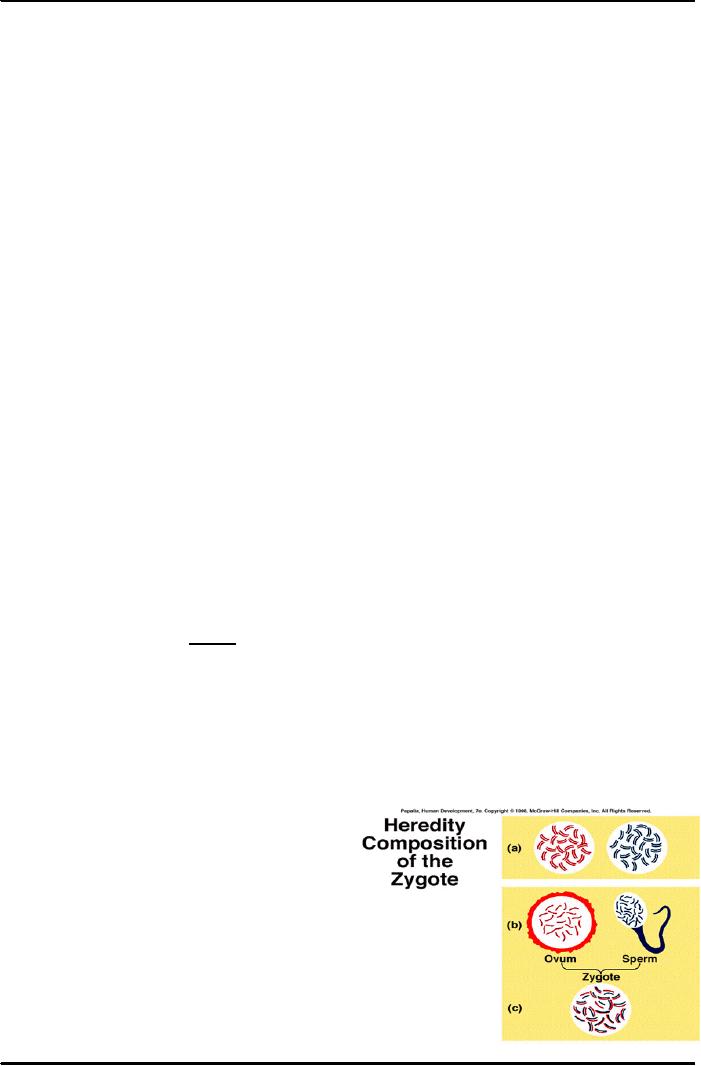 |

Introduction
to Psychology PSY101
VU
Lesson
10
PHYSICAL
DEVELOPMENT AND NATURE NURTURE
ISSUE
Development
"The
process of growth and
differentiation"
Development
refers to the progressive
changes in size, shape, and
function during the life of
an
organism
by which its genetic
potentials (genotype) are
translated into functioning
mature systems
(phenotype).
Most modern philosophical
outlooks would consider that
development of some
kind
or
other characterizes all
things, in both the physical
and biological
worlds.
Developmental
Psychology
The
branch of psychology that studies how
growth and physiological/ psychological/
social
changes
take place over the
life span
Also
called Life-span Psychology, it is
concerned with the changes in cognitive,
motivational, psycho-
physiological,
and social functioning that
occur throughout the human
life span. During the 19th
and early
20th
centuries, developmental psychologists
were concerned primarily
with child psychology.
Human
Development
�
Biological
sense: progressive change in
size, shape, and function,
of the body during the life
span;
the
genetic potentials are translated
into functioning adult
systems
�
Psychological
sense: the ways by which
physical, cognitive and
psychosocial characteristics
change
over life span; such
development is complex, systematic, and
age- related
�
Developmental
changes can be quantitative
and easy to measure such as
height and weight and
the
expansion of vocabulary
�
Developmental
changes can be qualitative
i.e., changes in kinds that
are more complex and
involve
"leaps" in functioning. these distinguish
a crawling baby from a walking
child, a non-
verbal
child from a talking child,
self- absorbed adolescent
from a mature adult
Psychological
changes include the growth
of:
�
Learning
�
Cognition
�
Intelligence
�
Emotional
maturity
�
Creativity
�
Sociability
�
Morality...and
much more
These
small leaps are based
upon small series of steps
that we continue to take throughout
our life span
Issues
of Interest to Developmental
Psychologists
Is
development continuous or
discontinuous?
Some
psychologists believed that human
functioning does not undergo fundamental
changes but instead
changes
gradually in its efficiency and
working capacity; initially a
child spoke a few words but
gradually
these
words become longer and
more complicated, increasing the child's
ability to remember and use
them
in
sentences.
Other
psychologists maintain that changes in
development reflect psychological processes
that mediate
human
functioning. These are
qualitatively unique stages, in which the
evolution of one stage may
depend
on
the traits of the preceding stages. e.g.
Roger Brown, psychologist,
maintains that in the process
of
language
acquisition, a child progresses
systematically in five steps or
stages. Each stage has
its own set of
rules
and skills from which a
higher level of language acquisition takes
place.
57

Introduction
to Psychology PSY101
VU
Jean
Piaget maintained that cognitive
development occurs in a series of steps
in which the child
acquires
and
uses unique sets of cognitive
processes that allow the
child to think in identifiable
ways.
Is
development general or
specific?
�
Many
aspects of functioning show
simultaneous changes; a co-occurrence of
change in different
situations.
�
Changes
occur in specific areas of
functioning that do not
occur in other level of
functioning.
�
Development
may remain isolated in
specific domains.e.g. Video
game mastery in young
boys
Is
development stable or
changing?
In
some respects development is stable
and stays there for very
long, whereas in some ways
it keeps
moving.
Temporal
aspect: degree
of stability or change across the
lifespan
Situational
aspect: degree
of stability or change across a wide
variety of experiences.e.g.
Aggressive
behavior
in children
Humans
active or passive
beings?
Psychologists
maintain that humans are
active recipients as well as participants
in their course of
development.
Man seeks to understand the
strategies that he can adopt
in order to influence development
Jean
Piaget emphasized the active
participation of the child in acquiring
cognitive skills__ acquisition of
knowledge
and ability to use it
effectively.
Some
philosophers believed that humans are
passive beings whose development is
entirely dependent on
the
environmental stimuli/ forces.
These conditions may be
internal i.e. food, water, companionship
etc or
external
i.e. previously experienced reward or
punishment
These
psychologists tend to view
differences in the patterns of development in
which an individual is
exposed
to different environmental
situations
Nature
versus Nurture
�
Nature
means hereditary influences.
�
Nurture
refers to environmental influences, in
child development.
�
Once,
it was assumed that these
were significant forces that
operated independently of each
other.
�
In
the 17th century the French philosopher
Ren� Descartes set out
views which held that
people
possess certain inborn ideas
that are long lasting
and color people's approach
to the
world.
�
The
British philosophers Thomas Hobbes
and John Locke, on the other hand,
took a more
empirical
approach and emphasized the
role of experience as fully
contributing to behavioral
development.
�
Since
the days of Descates, Hobbes, and Locke,
the empirical "nature" approach has led
to a
lot
of debate; many followers
and many opponents.
�
Mid
to late 1800's, through to the
early 1900's the nature
approach was the sole
standpoint;
consistent
with the scientific discoveries of the
role of inheritance and natural selection
by
Mendel
and Darwin
�
The
psychological argument developed later;
Francis Galton "Hereditary
Genius" (1869);
"gifted
individuals"
tended to come from
families, which had other
gifted individuals. He went on to
analyze
biographical dictionaries and encyclopedias,
and became convinced that talent in
science,
professions,
and the arts, ran in
families.
�
Galton
went even further arguing
that it would be "quite
practicable to produce a high gifted
race
of
men by judicious marriages during
several consecutive
generations".
�
Eugenics:
"the study of the agencies under
social control that may
improve or repair the racial
qualities
of future generations, either physically
or mentally."
For
Galton
�
"What
Nature does blindly, slowly,
and ruthlessly, man may do
providently, quickly,
and
kindly"
�
"Intelligence
must be bred, not
trained".
58

Introduction
to Psychology PSY101
VU
�
Such
arguments have had massive
social consequences and have
been used to support
apartheid
policies, sterilization programs, and
other acts of withholding
basic human rights
from
minority groups
The
later scientists, especially the
behaviorists contested such an
approach and advocated the
role and
significance
of environmental influences
Prevalent
Approach
�
Both
influences are essential and
are mutually influential.
The role of interaction
between
heredity
and environment together is important.
e.g., how a child responds
to parenting--an
environmental
influence--is partly determined by the child's
temperament and other
inherited
characteristics.
�
The
environment influences how hereditary
characteristics develop and are
expressed e.g.
increase
in average height during the
last century because of
improved nutrition and
medical
care.
�
Even
though many features of personality
are based on inherited
temperament, the family
environment
is an important influence on a child's personality
development.
�
A
child with a difficult or unpredictable
temperament can develop positively in a
warm and
loving
family environment.
�
Intelligence
is an inherited feature but the
way it is utilized largely
depends on the
environmental
conditions.
Characteristics
with Strong Genetic
Components
�
Physical
Characteristics
�
Intellectual
Characteristics
�
Emotional
Characteristics and
Disorders
Physical
Characteristics
�
Height
�
Weight
�
Obesity
�
Tone
of voice
�
Blood
Pressure
�
Tooth
decay
�
Athletic
ability
�
Firmness
of hand shake
�
Age
of death
�
Activity
level
Intellectual
Characteristics
�
Memory
�
Ability
as measured on intelligence test
�
Age
of language acquisition
�
Reading
disability
�
Mental
retardation
Emotional
Characteristics and
Disorders
�
Shyness
�
Extraversion
�
Emotionality
�
Neuroticism
�
Schizophrenia
59

Introduction
to Psychology PSY101
VU
�
Anxiety
�
Alcoholism
Prenatal
Environmental Influences
�
Mother's
nutrition and emotional
state
�
Illness
of mother
�
Mother's
use of drugs
�
Birth
complications
Studies
to Determine the Relative
Importance of Nature or
Nurture
i.
Twin Studies
�
Studies
making use of twins, identical or fraternal...reared
apart and reared
together
�
The
case of Gerald Levey and
Mark Newman, twins reared apart,
who had not seen
each other before:
When
method, both were bald, 6 and a
half feet tall, volunteer
fire fighters, 250 pounds in weight,
had
droopy
moustaches, wearing key
rings on right side of their
belts, liked to wear aviator
style dark
glasses;
both had interest in similar
subjects, had jobs in the
supermarket, and liked tall,
slender
women
with long hair; had similar
hobbies, liked Chinese food
and same drinks; showed
similar
mannerism,
laugh similarly, and loved to
fight fire
Twin
Studies with Monozygotic
Twins
i.
Twins
reared apart: Same
genes-different environment
ii.
Twins
reared together: Same
genes-same environment
Twins
reared
Apart
Twin
Studies with Monozygotic
Twins
Twins
reared
Together
Twins
reared
Apart
Reared
together:
Same
genes-same
environment
Monozygoti
c
Twins
Twin
Studies with Dizygotic
Twins
a.
Twins
reared apart: Different
genes-different environment
b.
Twins
reared together: Different
genes-same environment
Twin
Studies with Dizygotic
Twins
Twins
Reared
Twins
Reared
Together
Apart
Reared
apart:
Reared
together:
Different
genes-
Different
genes-same
different
environment
environment
Fraternal/
Dizygotic
Twins
60

Introduction
to Psychology PSY101
VU
i.
Adoption Studies
Children
with different sets of
genes, brought up by same
parents...in same
environment.
ii.
Consanguinity Studies
Study
of as many blood relatives as
possible of a particular family; these
study the extent to which
certain
features/ characteristics are
shared.
iii.
Selective Breeding of Traits in
Animals
Certain
characteristics are cultivated in animals
(running in a maze, aggression,
obesity etc) and if it
is
transmitted
on to the next generation then that
trait is partly inherited.
These findings are
then
generalized
to humans.... although its
validity is doubtful
Research
on Nature- Nurture, Focusing on
Environmental Issues
�
Research
looking for possible
environmental causes for
certain traits/
behaviors
�
These
include prenatal studies, and
studies involving manipulation of the
environmental factors
e.g.
nutrition,
exercise, drugs, pollution
etc
�
These
involve comparing actual history:
surveys etc.
�
Limitations
of Nature-Nurture Research
o
Ethical
considerations in research with
humans
o
Not
all animal research can be
applied to humans
The
best solution probably is
the ex-post facto/
retrospective studies
Heredity
and Physical Development
Researchers
believe that although
environment exerts an important influence
on human development,
physical
traits are the ones more
evidently influenced by heredity.
Personality and intellectual
characteristics
are
also affected by it
Mechanism
of Heredity: Transmission of Genetic
Characteristics
The
process begins from the
moment of conception; a sperm
from the father unites
with the ovum/
egg
of the mother to form
zygote, a single-cell/one-celled product,
containing the complete
genetic
package
for the one to be born
much later
The
zygote contains 23 pairs of
chromosomes
Chromosomes
�
Each
sperm and ovum contains 23
chromosomes that are tiny
rod- shaped particles
containing
genetic/
heredity information.
�
Genetic/
heredity information is packed in the
genes.
�
Genes:
parts
of chromosome that
are
the transmitters of inheritance.
�
Genes
produce
particular
characteristics
of the new being,
either
individually or in combination
Genes
may be dominant or recessive;
a
dominant
gene means that its
characteristics will
dominate
those of the recessive one
e.g. if father
has
brown eyes and mother
has black eyes,
and
if
the father's genes dominate then the
baby will
have
brown eyes.
o
Each
zygote's 46 chromosomes contain
about
30,000 segments strung along
its
61

Introduction
to Psychology PSY101
VU
beads
i.e., "genes"
Genes,
made
up of Deoxyribonucleic
Acid (DNA,) determine
all our heredity
Prenatal
Stages
EMBRYO:
A developed
zygote with a heart, a brain
and other organs.
Fetus:
A developing
child; 9 weeks after conception till
birth.
Determination
of the Sex of the
Embryo
�
A
combination of chromosomes from the
parents determines
sex.
�
An
XX pair means a female will
be born An XY pair means a
male will be born.
�
The
mother's sex chromosome is
always and `X' but the
father may be either `X' or
`Y'. If X
chromosome
is being contributed by the father's side
then the new being has to be a
female;
and
if the father is contributing a `Y'
chromosome then the new being is going to
be a male
Genotype
and Phenotype
�
Genotype:
genetic
composition of a person.
�
Phenotype:
observable
characteristics.
�
The
characteristics that can be
observed and seen, make up
our "phenotype". They may
not
always
be the same e.g. person may
have brown eyes (phenotype)
but carry genes for
both
brown
and blue eyes (genotype) __
dominant gene is
brown
Alleles
o
This
difference in color is due to the fact
that genes come in alternative forms
called "Alleles"
(alternative
forms of a gene). When alleles
are identical, a person is homozygous
for a trait; when
alleles
are dissimilar the person is
heterozygous
Patterns
of Transmission of
Characteristics
i.
Homozygous
and Heterozygous
When
the person inherits identical alleles he is
said to be "homozygous" (possessing
two identical alleles
for
a trait). When he inherits two
different alleles then the
person is "heterozygous" (possessing
two
different
alleles for a trait).
Example:
when a
person is homozygous for
brown eyes then he will
transmit only genes for
brown
eyes
to his offspring and if
heterozygous for blue and
brown eyes then although
dominant one is
brown,
but he will transfer his
both alleles to his
offspring.
a.
Autosomal Dominant Inheritance
�
Patterns
of inheritance in which a specific gene
is dominant; if it is inherited; it
manifests
itself
in the person.
b.
Autosomal Recessive
Inheritance
�
Patterns
of inheritance in which trait appears
only if a person inherits two
genes for it,
one
from
each parent. If the person inherits
only one gene for a
trait, it will not appear in
a person
but
may be passed on to his
children.
ii.
Multi-
Factorial Inheritance
�
Patterns
of inheritance in which a trait is
expressed either by a combination of
several genes or
through
the interaction of genes with
environmental factors.
�
More
complicated combination of genes or an
interaction between genetic
predispositions and
environmental
factors that bring them
out.
�
Some
characteristics follows one of
these patterns, other genes
another.
62

Introduction
to Psychology PSY101
VU
Examples
Hair
type (curly or straight)
is either autosomal dominant or autosomal
recessive, baldness is
sex-
linked;
height and weight are
probably multi- factorial.
Some
diseases and birth defect
are inherited according to
these patterns. Most
prominent examples
are:
Achondroplasia:
a kind
of dwarfism that is inherited by
autosomal dominance.
Tay-
Sachs disease: body's
inability to break down fat;
results into death by 3-4
years of age
Huntington's
disease:
99.9% correlation between having the
identified gene and the
disease.
The
blood- clotting disorder hemophilia
is a
sex- linked
condition.
Spina
bifida: a
defect in the closure of the vertebral
canal, that is believed to be the
condition
transmitted
by sex- linked inheritance
The
process of development continues
throughout the life
span
While
considering aspects of development,
individuality and interactions are the
key terms in understanding
it.
All beings bring their
unique genetic package into this
world and have unique sets
of experiences too.
An
individual's strengths, abilities, and
predispositions are affected by the influence of
environment. These
influences
make a person act in ways
that elicit new
experiences
63
Table of Contents:
- WHAT IS PSYCHOLOGY?:Theoretical perspectives of psychology
- HISTORICAL ROOTS OF MODERN PSYCHOLOGY:HIPPOCRATES, PLATO
- SCHOOLS OF THOUGHT:Biological Approach, Psychodynamic Approach
- PERSPECTIVE/MODEL/APPROACH:Narcosis, Chemotherapy
- THE PSYCHODYNAMIC APPROACH/ MODEL:Psychic Determinism, Preconscious
- BEHAVIORAL APPROACH:Behaviorist Analysis, Basic Terminology, Basic Terminology
- THE HUMANISTIC APPROACH AND THE COGNITIVE APPROACH:Rogers’ Approach
- RESEARCH METHODS IN PSYCHOLOGY (I):Scientific Nature of Psychology
- RESEARCH METHODS IN PSYCHOLOGY (II):Experimental Research
- PHYSICAL DEVELOPMENT AND NATURE NURTURE ISSUE:Nature versus Nurture
- COGNITIVE DEVELOPMENT:Socio- Cultural Factor, The Individual and the Group
- NERVOUS SYSTEM (1):Biological Bases of Behavior, Terminal Buttons
- NERVOUS SYSTEM (2):Membranes of the Brain, Association Areas, Spinal Cord
- ENDOCRINE SYSTEM:Pineal Gland, Pituitary Gland, Dwarfism
- SENSATION:The Human Eye, Cornea, Sclera, Pupil, Iris, Lens
- HEARING (AUDITION) AND BALANCE:The Outer Ear, Auditory Canal
- PERCEPTION I:Max Wertheimer, Figure and Ground, Law of Closure
- PERCEPTION II:Depth Perception, Relative Height, Linear Perspective
- ALTERED STATES OF CONSCIOUSNESS:Electroencephalogram, Hypnosis
- LEARNING:Motor Learning, Problem Solving, Basic Terminology, Conditioning
- OPERANT CONDITIONING:Negative Rein forcer, Punishment, No reinforcement
- COGNITIVE APPROACH:Approach to Learning, Observational Learning
- MEMORY I:Functions of Memory, Encoding and Recoding, Retrieval
- MEMORY II:Long-Term Memory, Declarative Memory, Procedural Memory
- MEMORY III:Memory Disorders/Dysfunctions, Amnesia, Dementia
- SECONDARY/ LEARNT/ PSYCHOLOGICAL MOTIVES:Curiosity, Need for affiliation
- EMOTIONS I:Defining Emotions, Behavioral component, Cognitive component
- EMOTIONS II:Respiratory Changes, Pupillometrics, Glandular Responses
- COGNITION AND THINKING:Cognitive Psychology, Mental Images, Concepts
- THINKING, REASONING, PROBLEM- SOLVING AND CREATIVITY:Mental shortcuts
- PERSONALITY I:Definition of Personality, Theories of Personality
- PERSONALITY II:Surface traits, Source Traits, For learning theorists, Albert Bandura
- PERSONALITY III:Assessment of Personality, Interview, Behavioral Assessment
- INTELLIGENCE:The History of Measurement of Intelligence, Later Revisions
- PSYCHOPATHOLOGY:Plato, Aristotle, Asclepiades, In The Middle Ages
- ABNORMAL BEHAVIOR I:Medical Perspective, Psychodynamic Perspective
- ABNORMAL BEHAVIOR II:Hypochondriasis, Conversion Disorders, Causes include
- PSYCHOTHERAPY I:Psychotherapeutic Orientations, Clinical Psychologists
- PSYCHOTHERAPY II:Behavior Modification, Shaping, Humanistic Therapies
- POPULAR AREAS OF PSYCHOLOGY:ABC MODEL, Factors affecting attitude change
- HEALTH PSYCHOLOGY:Understanding Health, Observational Learning
- INDUSTRIAL/ORGANIZATIONAL PSYCHOLOGY:‘Hard’ Criteria and ‘Soft’ Criteria
- CONSUMER PSYCHOLOGY:Focus of Interest, Consumer Psychologist
- SPORT PSYCHOLOGY:Some Research Findings, Arousal level
- FORENSIC PSYCHOLOGY:Origin and History of Forensic Psychology